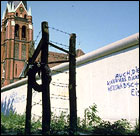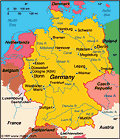The Berlin Wall

A look back at the fall of Communism and Soviet influence
 The Berlin Wall Related Links
|
Major anti-Communist riots broke out in East Berlin in June 1953 and, on August 13, 1961, the Soviet Sector was sealed off with a wall that ran through the city. The Communist-built wall was intended to stem the flood of refugees seeking freedom in the West. Approximately 200,000 had already made the move in 1961, before the wall was erected.
In addition, Communist East Germany wanted to isolate the citizens of East Berlin from the West, and did so with 27 miles of concrete and barbed wire. The fall of that edifice 31 years later came to symbolize the collapse of Soviet influence in Europe.
On November 9, 1989, several weeks after the resignation of East Germany's long-time Communist leader, Erich Honecker, also the wall's designer and chief proponent, the East German government opened its borders to the West and allowed thousands of citizens to pass freely through the Berlin Wall. They were cheered and greeted by hordes of West Berliners, and many of the jubilant newcomers celebrated their new freedom by climbing to the top of the despised wall.
The following day, East German troops began dismantling parts of the wall. It was ironic that the wall was built to keep the citizens from leaving and, 28 years later, it was being dismantled for the same reason. On November 22, new passages were opened at the north and south ends of the Brandenburg Gate in an emotional ceremony attended by Chancellor Helmut Kohl of West Germany and Chancellor Hans Modrow of East Germany.
The opening of the Brandenburg Gate climaxed the ending of the barriers that had divided the German people since the end of World War II. By the end of 1990, the entire wall had been removed.







